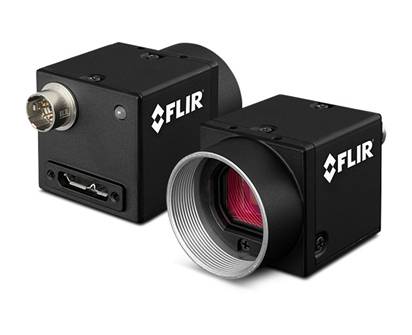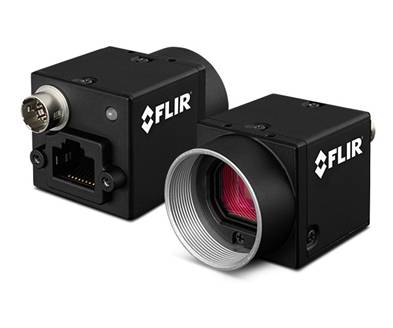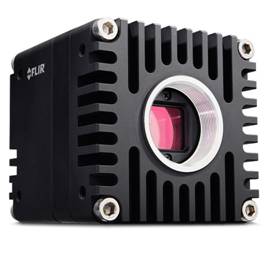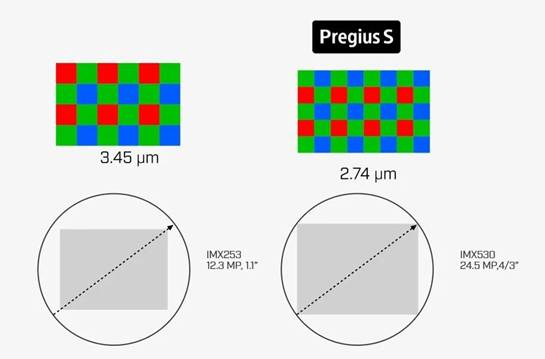“The shutter of the camera determines how and when the light is recorded with each exposure. Today, Philip will introduce to you how the Sony Pregius series global shutter CMOS sensor provides clear and distortion-free images.
“
The shutter of the camera determines how and when the light is recorded with each exposure. Today, Philip will introduce to you how the Sony Pregius series global shutter CMOS sensor provides clear and distortion-free images.

The BSI sensor inverts the traditional front-illuminated sensor design, making it easier for photons to enter the light-sensitive photodiode of each pixel. The fourth-generation Pregius S continues the legacy of compact performance and literally turns sensor design rules upside down. The Pregius S features a Backside Illuminated (BSI) sensor to reduce pixel size, increase resolution, and simultaneously increase quantum efficiency and sensitivity.
initial model
Initial models with Pregius S sensors are currently:
The FLIR Blackfly® S features the industry’s most advanced ice cube shape sensor, which is powerful enough to make it easy to generate the precise images you need and accelerate the development of your applications. FLIR Blackfly S USB3 with IMX540 24.5 MP (15 fps): Monochrome, Color and FLIR Blackfly S GigE with IMX542 16 MP (7.5 fps) are global shutter sensors.

Blackfly S USB3

Blackfly S GigE
The FLIR Oryx 10GigE camera family supports transfer speeds up to 10Gbit/s and is capable of capturing 12-bit images in 4K resolution at frame rates in excess of 60FPS, allowing system designers to take full advantage of the latest sensors. Also, the FLIR Oryx 10GigE is a global shutter sensor with IMX530 24.5 MP (35 fps).

The Pregius S offers high resolution in a compact sensor size without compromising imaging performance, reducing system cost and increasing throughput.
1. Higher resolution and lower complexity
The 24.5 MP IMX530/540 are the first sensors in the Pregius S series to replace a wide range of low-resolution cameras, reducing your system complexity and cost.
2. Get better imaging performance at a lower price
The new 2.74 μm pixels of the Pregius S sensor are nearly double the pixel density of the previous Pregius sensor. The resulting footprint shrinks, allowing the use of compact, affordable optics, condensing a 24.5MP global shutter CMOS sensor into a space the size of an ice cube, at a fairly competitive price.

Pixel size differences between different generations of Sony Pregius sensors
The new pixel design also significantly reduces lens shadows for compact C-mount lenses with sensor sizes up to 4/3 inch (about 1.9 cm). The back-illuminated pixel design can receive incident light at higher angles, helping to improve image quality with low-cost electronics. The Pregius S makes it possible to use a compact lens on a large, high-resolution sensor without sacrificing image quality.

Compared to the IMX530/540 Pregius S sensors, the IMX253 Pregius sensor has a higher pixel density.

Shadow comparison of the same compact lens on the 1.1-inch (~2.7cm) IMX253 Pregius sensor versus the 4/3 English (~1.9cm) IMX530/540 Pregius S sensor.
3. Increase system throughput
Global shutter readout ensures distortion-free capture of fast-moving targets. Higher sensitivity reduces exposure time and increases throughput, enabling you to analyze and inspect merchandise in less time and increase line speed.
4. Reduce lighting costs

The Sony Pregius S sensor combines the fast global shutter readout and low read noise of previous generations of Pregius with the high quantum efficiency and pixel density of STARVIS.
The Pregius S sensor reduces exposure time in low light. For example, the IMX530/540 can achieve an excellent quantum efficiency of up to 71.5%, which is higher than the 65% of previous generations of global shutter sensors. Since the new back-illuminated pixel design will continue to retain the expected low read noise and high image quality of the Pregius sensor, the upgrade will not compromise performance.

Although the front-illuminated IMX250 has larger pixels, the peak QE of the BSI IMX530/540 is higher.

Pregius S retains low read noise
Sony has established a new benchmark for CMOS imaging sensors by combining the global shutter readout and low read noise of the Pregius sensor with the high quantum efficiency and pixel density of STARVIS.
Application advantages

As sensing moves towards fully vision-based systems, enabling connected devices to truly “see” and interpret their environment, global shutter technology represents a major step forward in producing high-quality images, even under challenging conditions The same is true below.
The Links: SEMIX302GB126V1 NL6448BC26-22F